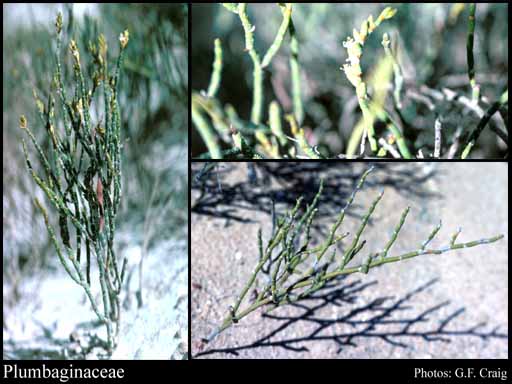- Reference
- Gen.Pl. [Jussieu] 92 (1789)
- Name Status
- Current

Scientific Description
Common name. Leadwort Family.
Habit and leaf form. Herbs (usually), or herbaceous climbers, or shrubs, or lianas. Perennial; plants with a basal concentration of leaves, or with neither basal nor terminal concentrations of leaves. Self supporting, or climbing; sometimes stem twiners. Plumbago twining clockwise. Helophytic, or mesophytic, or xerophytic (especially salt steppes and maritime). Leaves alternate; spiral; ‘herbaceous’, or leathery (Aegialitis); petiolate to sessile; sheathing (Eagialitis), or non-sheathing; simple; epulvinate. Leaf blades dissected, or entire; often acicular, or linear, or oblong (narrow); when dissected, pinnatifid; pinnately veined, or palmately veined to parallel-veined (Aegialitis). Leaves with stipules, or without stipules; without a persistent basal meristem. Stem anatomy. Nodes tri-lacunar. Secondary thickening developing from a conventional cambial ring, or anomalous (often); commonly via concentric cambia.
Reproductive type, pollination. Fertile flowers hermaphrodite. Unisexual flowers absent. Plants hermaphrodite. Plants heterostylous (often, and the pollen often dimorphic in Armerioideae), or heterostylous. Entomophilous; via hymenoptera, via lepidoptera, and via diptera.
Inflorescence and flower features. Flowers aggregated in ‘inflorescences’; in panicles, or in heads, or in racemes. The terminal inflorescence unit cymose, or racemose. Inflorescences scapiflorous, or not scapiflorous; variously panicles or cymose heads (Armerioideae) or racemes (Plumbaginoideae). Flowers bracteolate; small; regular; 5 merous; cyclic; tetracyclic. Free hypanthium absent. Hypogynous disk absent. Perianth with distinct calyx and corolla (but the calyx often petaloid); 10; 2 -whorled; isomerous. Calyx 5; 1 -whorled; gamosepalous (forming a 5 or ten ribbed tube); blunt-lobed, or toothed; valvate, or plicate in bud; regular; persistent. Corolla 5; 1 -whorled; gamopetalous, or polypetalous (or almost so); imbricate, or contorted; regular; white, or yellow, or red (or rose), or pink, or purple, or blue, or red and blue; fleshy (or leathery, in Aegialitis), or not fleshy; persistent (often), or deciduous (deciduous above and persistent below in Aegialitis). Petals when free clawed, or sessile. Androecium 5. Androecial members free of the perianth, or adnate (to the corolla, in Armerioideae); free of one another, or coherent (forming a persistent tube in Aegialitis); 1 -whorled. Androecium exclusively of fertile stamens. Stamens 5; isomerous with the perianth; alternisepalous; all opposite the corolla members. Anthers dorsifixed, or basifixed (Aegialitis); versatile, or non-versatile; dehiscing via longitudinal slits; introrse; tetrasporangiate. Gynoecium 5 carpelled. The pistil 1 celled. Carpels isomerous with the perianth. Gynoecium syncarpous; synovarious (Armerioideae, Aegialitis), or synstylovarious to eu-syncarpous; superior. Ovary unilocular; 1 locular. Styles 1, or 5 (opposite the sepals); when five, free to partially joined; apical. Stigmas dry type; papillate; Group II type. Placentation basal. Ovules in the single cavity 1; pendulous (from a long, basally attached funicle); anatropous (or circinnotropous).
Fruit and seed features. Fruit dehiscent, or indehiscent; a capsule, or a nut. Capsules when dehiscent circumscissile, or valvular (with apical valves). Seeds endospermic, or non-endospermic; winged. Embryo well differentiated. Cotyledons 2. Embryo chlorophyllous (4/5); straight. Seedling. Germination phanerocotylar.
Physiology, biochemistry. Aluminium accumulation not found. Photosynthetic pathway: C3.
Geography, cytology, number of species. World distribution: cosmopolitan, especially salt steppes and coasts. X = 6–9 (mostly). 775 species.
Keys
Western Australian Genera and Families of Flowering Plants — an interactive key
T.D. Macfarlane, L. Watson, N.G. Marchant